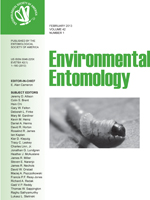Classical biological control against the alfalfa weevil, Hypera postica (Gyllenhal), a destructive pest of alfalfa (Medicago sativa L.), has resulted in the establishment of nine parasitoid species in the United States. Despite widespread redistribution of a number of species, there remains little postrelease data on their establishment and potential effectiveness in many regions. I surveyed parasitoids associated with alfalfa weevil larvae across 30 or more sites in eastern Montana and western North Dakota over 2 yr. Replicate sites were sampled in two habitat types that differ in their physical characteristics, flood-irrigated and dryland alfalfa fields. Irrigated systems are more productive but also more intensively disturbed habitats because of increased harvest frequency and repeated flooding. Given evidence that both habitat disturbance and herbivore density, which often increases with productivity, can influence parasitoid dynamics, I predicted that parasitism levels, the relative importance of different species, or both, would differ across these two system types. Of four larval parasitoid species released previously or recovered in the region, two were found in this study, Bathyplectes curculionis (Thomson) and Oomyzus incertus (Ratzenberg), with average levels of parasitism across habitat types and years of 37.2 and 3.5%, respectively. Parasitism levels differed between habitat types, but the effect was driven by concomitant differences in host densities that were higher in irrigated than dryland fields. Parasitoid responses to host density varied across years and species. B. curculionis exhibited positive density dependence in parasitism across sites in 2009 and negative density dependence in 2010 when host densities were higher regionally. In contrast, O. incertus exhibited positive density dependence in 2010. Our results suggest that these species may be differentially effective at different host densities. Thus, variation in host density could represent an important axis along which parasitoids exhibit spatial complementarity in function.
How to translate text using browser tools
1 February 2013
Host Density Drives Spatial Variation in Parasitism of the Alfalfa Weevil, Hypera postica, Across Dryland and Irrigated Alfalfa Cropping Systems
Tatyana A. Rand
ACCESS THE FULL ARTICLE
It is not available for individual sale.
This article is only available to subscribers.
It is not available for individual sale.
It is not available for individual sale.

Environmental Entomology
Vol. 42 • No. 1
February 2013
Vol. 42 • No. 1
February 2013
density-dependence
disturbance
natural enemy
population
spatial variation




